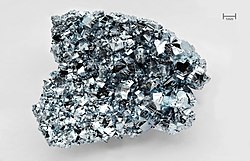Heavy metals
Heavy metals are metals or chemical compounds containing metals with relatively high density, high atomic weights, or atomic numbers.
This might mean up to 96 out of the 118 known chemical elements. Mercury, lead and bismuth are examples. The term is widely used in science. They have a density of more than 5 g/cm3.[1] All of them are denser than iron
The term is sometimes used for any toxic metal, or metalloid such as arsenic,[2] regardless of density.[3]
The term heavy metals includes chromium, cobalt, nickel, copper, zinc, arsenic, silver, gold, cadmium, antimony, mercury, thallium, tungsten, platinum and lead.
The heaviest metal by density is osmium. Although most heavy metals are toxic, not all of them are. For example, gold, which is one of the heaviest metals, is non-toxic and chemically inert in the body. Some gold compounds are toxic, however. More specific definitions of a heavy metal have been proposed but none is widely used. One common definition of a heavy metal is that it has a density and/or atomic number higher than iron.
Heavy metals are scarce in the Earth's crust because most have sunk into the Earth's core. Many are used in modern life. They are used, for example, in golf clubs, cars, antiseptics, self-cleaning ovens, plastics, solar panels, mobile phones, and particle accelerators.
Heavy Metals Media
Cerium(IV) oxide is used as a catalyst in self-cleaning ovens.
Chromium crystalsand 1 cm3 cube
Arsenic, sealed in acontainer to stop tarnishing
Cadmium barand 1 cm3 cube
Mercury beingpoured into a petri dish
Oxidised leadnodules and 1 cm3 cube
References
- Kumar V, Abbas AK & Aster JC 2013, 'Environmental and nutritional diseases,' in V Kumar, AK Abbas & JC Aster (eds), Robbins basic pathology, 9th ed, Elsevier, Philadelphia, PA. ISBN 978-1-4377-1781-5
- Newman MC & Unger MA 2003. Fundamentals of ecotoxicology, 2nd ed. Lewis, Boca Raton, FL. ISBN 1566705983
- Sengupta AK 2002, 'Principles of heavy metals separation', in AK Sengupta (ed), Environmental separation of heavy metals: engineering processes, Lewis, Boca Raton, FL. ISBN 1566768845









